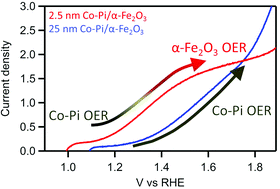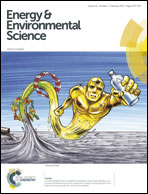Mechanistic insights into solar water oxidation by cobalt-phosphate-modified α-Fe2O3 photoanodes†
Abstract
Interfacing α-Fe2O3 photoanodes with the water-oxidation electrocatalyst Co-Pi is known to enhance their photon-to-current conversion efficiencies by reducing electron–hole recombination near their surfaces, particularly at more negative potentials, but the mechanism by which Co-Pi modification achieves this enhancement remains poorly understood. Conflicting experimental observations have been recorded with respect to the role of Co-Pi thickness and even the participation of Co-Pi in catalysis, raising important general questions concerning the fundamental properties of catalyst-modified PEC water-oxidation photoanodes for solar energy conversion. Here, we report results from electrochemical, spectroscopic, and microscopic measurements on mesostructured Co-Pi/α-Fe2O3 composite photoanodes that reveal evolving pathways of water oxidation with increasing Co-Pi thickness. These results highlight major fundamental differences between structured and planar Co-Pi/α-Fe2O3 composite photoanodes and help to reconcile previously conflicting mechanistic interpretations.


 Please wait while we load your content...
Please wait while we load your content...